An Ancient Egyptian Tomb: A Testament to a “Timeless” Civilization.
According to Live Science, this unique tomb was discovered near Aswan, Egypt, in the ancient cemetery of Qubbet el-Hawa, which houses the remains of two leaders from ancient city-states. In antiquity, tomb robbers managed to take most of the valuable artifacts, including two mummies; however, the tomb itself remains an unparalleled treasure.
This ancient Egyptian tomb features an original chapel that was meant to house a statue of the governor or lord who commissioned the tomb, although the construction was never completed. Inside the chapel is a statue that remains unfinished. The reason for this is still unclear.

Entrance to the chapel of the ancient Egyptian tomb – (Photo: University of Jaén and Málaga).
However, the most unique aspect lies in the architecture of the chapel. Every year on the Winter Solstice (December 22), the entire chapel illuminates brilliantly.
This mysterious phenomenon is, in fact, pure science: the entrance to the chapel was meticulously calculated during construction so that the sunlight on the winter solstice would shine directly inside – and only on that day can the sunlight fully illuminate the interior of the chapel.
This once again affirms the “timeless” civilization of ancient Egyptians, who possessed advanced knowledge in various fields, including astronomy and mathematics, particularly spatial geometry, which enabled them to construct wonders like this ancient tomb.

Special structure of the chapel – (Photo: University of Jaén and Málaga).
“The winter solstice marks the beginning of the daily victory of light over darkness, culminating in the summer solstice”; “After the winter solstice, the days start to get longer, understood as a rebirth. This concept is transferred to the physical world, specifically illuminating the statue of the deceased governor” – explained researchers María Dolores Joyanes Díaz and Alejandro Jiménez-Serano from the University of Jaén and Málaga.
This ancient Egyptian tomb was first discovered in 1885 by Egyptologist Sir Ernest Alfred Thompson Wallis Budge, but it wasn’t until the period from 2008 to 2018 that it was excavated. Analysis results indicate that the tomb is 3,800 years old.




















































